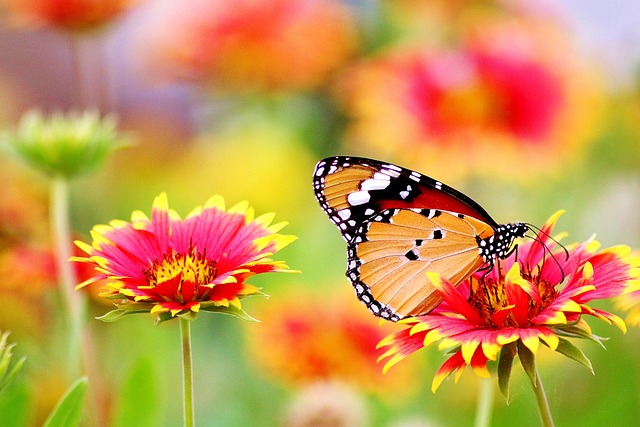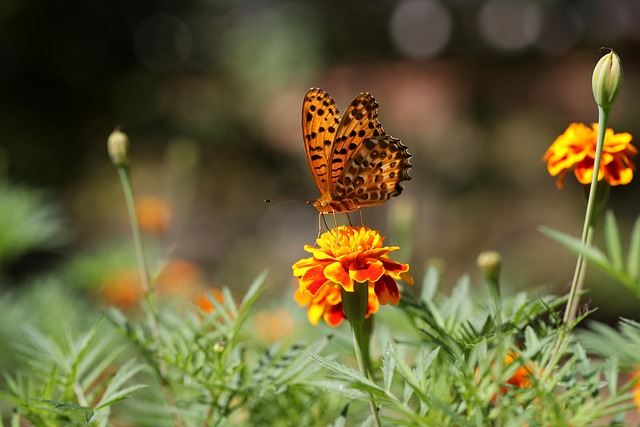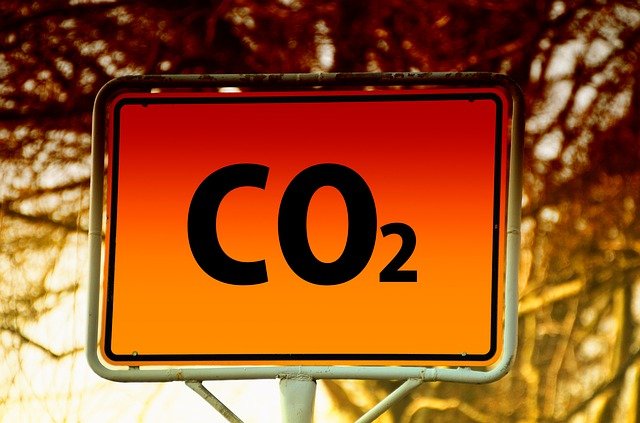Butterflies are attractive insects that play an important role in pollinating plants and preserving environmental equilibrium. In Pakistan, butterflies are essential not just for their ecological value, but also for their cultural value, as they are employed in traditional art and crafts. However, the butterfly population in Pakistan is fast dropping due to a variety of reasons, including changes in agricultural practises. We shall discuss the impact of agricultural practices on butterfly populations in Pakistan in this blog.
Also cehck out: 17 Beautiful Butterfly Species That Are Found in Pakistan
Background
Pakistan is an agricultural country, with agriculture serving as the economic backbone. However, agricultural practises in Pakistan have changed significantly throughout the years, especially in the last few decades. Pesticides, insecticides, and herbicides have been used more to increase crop yield, but they have had a negative influence on the ecosystem, particularly butterfly populations. Butterflies are especially sensitive to environmental changes, and even minor changes in the ecosystem can have a large impact on their populations (Gabol et al., 2012; Mollier et al., 2017).
The Impact Of Agricultural Practices On Butterfly Populations
Pesticides and herbicides used in agriculture have been related to a drop in butterfly populations in Pakistan. Pesticides are used to combat crop pests, but they also harm beneficial insects like butterflies. The indiscriminate use of pesticides has resulted in a decrease in the number of host plants required by butterflies for survival. Host plants are required for caterpillars to grow and mature into butterflies (Ghazanfar et al., 2016; Nath et al., 2022; Tsatsakis et al., 2017).
Herbicides are used to kill weeds that compete for nutrients and resources with crops. They do, however, damage plants that butterflies rely on for food and refuge. As a result, the number of flowering plants on which butterflies rely for survival has decreased. As a result, butterfly populations in Pakistan are dropping at an alarming rate (Kumar, 2015; Nawaz et al.).
Chemical fertilizers used in agriculture have also had an impact on butterfly populations. Chemical fertilizers include high levels of nitrogen and phosphorus, which can increase the number of invasive plant species that compete for resources with native plants. As a result, the number of host and food plants on which butterflies rely for survival has decreased (Kraham, 2017; Sánchez-Bayo & Wyckhuys, 2019; Tabacco et al., 2023).
Furthermore, agricultural practices such deforestation, land conversion, and monoculture have contributed to a drop in butterfly populations in Pakistan. Deforestation and land conversion diminish the availability of natural butterfly habitats, while monoculture reduces the variety of plants on which butterflies rely for survival.

Also read: 10 Reason of Why Butterflies are Dying and How We Can Save Them
Conservation Measures
Several conservation strategies can be implemented in Pakistan to protect butterfly populations. Reduced usage of pesticides and herbicides in agriculture is one of the most effective approaches. Farmers can control pests and weeds using integrated pest management approaches that rely on natural predators, crop rotation, and other non-chemical methods (Mahmood et al., 2014; Nawaz & Ahmad, 2015; Pretty & Pervez Bharucha, 2015).
Planting native blooming plants in and around agricultural fields can provide butterflies with food and refuge. Farmers can also plant specific host plants that are required for caterpillar growth and development (Cutting & Tallamy, 2015; Jain et al., 2021).
Sustainable agriculture practices, such as organic farming, can also aid in the conservation of butterfly populations in Pakistan. Organic farming foregoes the use of synthetic pesticides, herbicides, and fertilisers in favour of natural ways of crop enhancement. This can result in a healthier ecosystem for butterfly populations (Ashraf et al., 2021; Rehman et al., 2022; Taki et al., 2022).
Furthermore, public education campaigns and educational programmes can assist raise knowledge about the importance of butterfly conservation and the influence of agricultural practises on butterfly populations. Farmers who adopt sustainable farming practises that benefit butterfly populations may also be rewarded by the government.
Also read: Sustainable Agriculture Practices and their Advantages
Conclusion
Butterflies are essential markers of ecosystem health and play a significant role in pollination plants. However, because to changes in farming methods, their populations in Pakistan are diminishing. The main causes of this loss are pesticides, herbicides, and chemical fertilizers, as well as deforestation, land conversion, and monoculture. It is critical to limit the use of toxic chemicals in agriculture and promote sustainable farming practises that support butterfly growth and development in order to conserve butterfly populations. Planting native blooming and host plants in and near agricultural fields can offer food and shelter for butterflies, while public awareness campaigns and educational programmes can raise knowledge about the importance of butterfly conservation.
Finally, it is critical to assess the influence of agricultural practises on butterfly populations in Pakistan and to implement the required conservation measures. A healthy ecosystem with a strong butterfly population benefits not just the environment but also the livelihoods of farmers who rely on pollinators to produce crops. It is time to implement sustainable farming practises that promote butterfly growth and development while also promoting a healthier environment for all.
You might also like to read: Pollinator Decline of Bees – Causes, Effects and Solutions
References:
- Ashraf, I., Ahmad, I., Nafees, M., Yousaf, M. M., & Ahmad, B. (2021). 01. A review on organic farming for sustainable agricultural production. Pure and Applied Biology (PAB), 5(2), 277-286.
- Cutting, B. T., & Tallamy, D. W. (2015). An evaluation of butterfly gardens for restoring habitat for the monarch butterfly (Lepidoptera: Danaidae). Environmental entomology, 44(5), 1328-1335.
- Gabol, W. A., Ahmed, A., Bux, H., Ahmed, K., Mahar, A., & Laghari, S. (2012). Genetically modified organisms (GMOs) in Pakistan. African Journal of Biotechnology, 11(12), 2807-2813.
- Ghazanfar, M., Malik, M. F., Hussain, M., Iqbal, R., & Younas, M. (2016). Butterflies and their contribution in ecosystem: A review. Journal of Entomology and Zoology Studies, 4(2), 115-118.
- Jain, A., Zeng, Y., & Webb, E. L. (2021). Critical dependence of butterflies on a non-native host plant in the urban tropics. Frontiers in Ecology and Evolution, 9, 655012.
- Kraham, S. J. (2017). Environmental impacts of industrial livestock production. International Farm Animal, Wildlife and Food Safety Law, 3-40.
- Kumar, V. (2015). A review on efficacy of biopesticides to control the agricultural insect’s pest. International Journal of Agricultural Science Research, 4(9), 168-179.
- Mahmood, R., Rehman, A., & Ahmad, M. (2014). Prospects of biological control of citrus insect pests in Pakistan. Journal of Agricultural Research (03681157), 52(2).
- Mollier, L., Seyler, F., Chotte, J.-L., & Ringler, C. (2017). End hunger, achieve food security and improved nutrition and promote sustainable agriculture: SDG 2. A Guide to SDG Interactions: From Science to Implementation; ICSU: Paris, France.
- Nath, R., Singh, H., & Mukherjee, S. (2022). Insect pollinators decline: an emerging concern of Anthropocene epoch. Journal of Apicultural Research, 1-16.
- Nawaz, A., & Ahmad, J. N. (2015). Insect pest management in conservation agriculture. Conservation agriculture, 133-155.
- Nawaz, A., Gogi, M. D., Sufyan, M., Arif, M. J., & Plantegenest, M. Integrated Insect Pest Management Strategies for Major Vegetables Crops.
- Pretty, J., & Pervez Bharucha, Z. (2015). Integrated pest management for sustainable intensification of agriculture in Asia and Africa. Insects, 6(1), 152-182.
- Rehman, A., Farooq, M., Lee, D.-J., & Siddique, K. H. (2022). Sustainable agricultural practices for food security and ecosystem services. Environmental Science and Pollution Research, 1-20.
- Sánchez-Bayo, F., & Wyckhuys, K. A. (2019). Worldwide decline of the entomofauna: A review of its drivers. Biological Conservation, 232, 8-27.
- Tabacco, E., Ferrero, F., Busato, E., Pansa, M., Borreani, G., & Tavella, L. (2023). Field scale biodiversity in relation to the intensity grade of agricultural practices on dairy farms. European Journal of Agronomy, 145, 126777.
- Taki, R., Bag, A. G., Sadhik, S., Keerthika, B., & Kumar, K. V. S. (2022). The Role of Organic Farming for Sustainable Agriculture: An Approach to Economic Integrity. International Journal of Environment and Climate Change, 12(10), 943-953.
- Tsatsakis, A. M., Nawaz, M. A., Tutelyan, V. A., Golokhvast, K. S., Kalantzi, O.-I., Chung, D. H., . . . Yang, S. H. (2017). Impact on environment, ecosystem, diversity and health from culturing and using GMOs as feed and food. Food and Chemical Toxicology, 107, 108-121.
This article is written by: Mr. Qudrat Ullah
MPhil student of Environmental Science at Government College University Faisalabad. I’m dedicated and motivated individual with a passion for exploring the impact of human activities on the environment. My aim is to contribute towards creating a sustainable and healthy environment for the present and future generations.
I hope you all liked this post! Please comment below if you have any suggestions, comments, or feedback! We at #envpk love hearing from our readers! Thanks!




